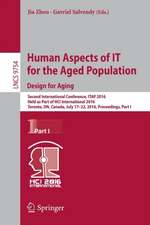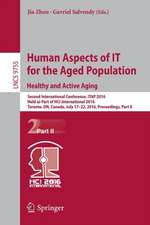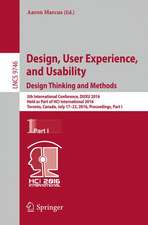Convergence: Breaking Down Barriers Between Disciplines: Proceedings of the International Conference on Healthcare Systems Ergonomics and Patient Safety, HEPS2022: Springer Series in Design and Innovation, cartea 30
Editat de Marijke Melles, Armaĝan Albayrak, Richard H.M. Goossensen Limba Engleză Hardback – 5 noi 2023
Din seria Springer Series in Design and Innovation
- 18%
 Preț: 1406.20 lei
Preț: 1406.20 lei - 18%
 Preț: 1012.08 lei
Preț: 1012.08 lei - 18%
 Preț: 1444.55 lei
Preț: 1444.55 lei - 18%
 Preț: 950.21 lei
Preț: 950.21 lei -
 Preț: 417.68 lei
Preț: 417.68 lei -
 Preț: 450.33 lei
Preț: 450.33 lei - 18%
 Preț: 1396.08 lei
Preț: 1396.08 lei - 18%
 Preț: 950.96 lei
Preț: 950.96 lei - 24%
 Preț: 707.54 lei
Preț: 707.54 lei -
 Preț: 263.28 lei
Preț: 263.28 lei - 18%
 Preț: 950.33 lei
Preț: 950.33 lei - 18%
 Preț: 1228.29 lei
Preț: 1228.29 lei - 15%
 Preț: 690.76 lei
Preț: 690.76 lei - 18%
 Preț: 1400.06 lei
Preț: 1400.06 lei - 20%
 Preț: 394.24 lei
Preț: 394.24 lei - 18%
 Preț: 942.63 lei
Preț: 942.63 lei - 18%
 Preț: 1550.30 lei
Preț: 1550.30 lei - 15%
 Preț: 646.62 lei
Preț: 646.62 lei - 18%
 Preț: 1409.21 lei
Preț: 1409.21 lei - 18%
 Preț: 887.55 lei
Preț: 887.55 lei - 18%
 Preț: 1219.16 lei
Preț: 1219.16 lei - 18%
 Preț: 898.58 lei
Preț: 898.58 lei - 15%
 Preț: 637.28 lei
Preț: 637.28 lei - 24%
 Preț: 1048.93 lei
Preț: 1048.93 lei - 18%
 Preț: 791.71 lei
Preț: 791.71 lei - 18%
 Preț: 791.71 lei
Preț: 791.71 lei
Preț: 1281.49 lei
Preț vechi: 1601.87 lei
-20% Nou
Puncte Express: 1922
Preț estimativ în valută:
245.29€ • 266.53$ • 206.18£
245.29€ • 266.53$ • 206.18£
Carte tipărită la comandă
Livrare economică 21 aprilie-05 mai
Preluare comenzi: 021 569.72.76
Specificații
ISBN-13: 9783031321979
ISBN-10: 3031321979
Pagini: 353
Ilustrații: XIII, 353 p. 77 illus., 56 illus. in color.
Dimensiuni: 155 x 235 mm
Greutate: 0.69 kg
Ediția:1st ed. 2024
Editura: Springer Nature Switzerland
Colecția Springer
Seria Springer Series in Design and Innovation
Locul publicării:Cham, Switzerland
ISBN-10: 3031321979
Pagini: 353
Ilustrații: XIII, 353 p. 77 illus., 56 illus. in color.
Dimensiuni: 155 x 235 mm
Greutate: 0.69 kg
Ediția:1st ed. 2024
Editura: Springer Nature Switzerland
Colecția Springer
Seria Springer Series in Design and Innovation
Locul publicării:Cham, Switzerland
Cuprins
Experimental investigation of anthropomorphic forms of a forearm support of a surgical arm assistance system in precision tasks.- Comparing the active, functional, and passive range of motion of finger joints using dynamic measurement.- Using inflatable cushions is significantly less straining than manually proning patients.- Using cognitive ergonomics and metacognition processes for understanding and improving medication safety systems.- Qualitative assessment of a new labelling design of injectable generic medicines.- Patient handling in a general critical unit: an ergonomics evaluation guided by MAPHO tool.- A multi-professional approach to investigating musculoskeletal injuries among medical radiation technologists: a case study for new equipment.- Human Computer Interaction (HCI) in general radiography (x-ray): a case study to consider HCI factors when purchasing x-ray equipment.- Shared sensemaking and clinical decision-making in critical care from a SA-oriented dashboard.- Accountable risk management in healthcare during the COVID-19 pandemic; the role of STSA and AI.- Qualitative investigation of the novel use of shopping loyalty card data in medical decision making.- Care partner’s experience with care received in the Emergency Department.- The effect of psychological scarcity on health decisions of rural residents in China: preliminary results.- Patient and clinician perspectives on collaborative work in the emergency department.- Mapping contextual factors influencing physical activity behaviour of people with a physical demanding job.- Bringing HFE education and training closer to healthcare systems: the case of a Latin American network of practitioners and academics.- Multidisciplinary clinicians’ perspectives about barriers and facilitators to a team-based OR-to-ICU handoff.- Socio-technical systems analysis of medical ward rounds in an acute teaching hospital.- Patient vehicle extrication at the entry door of an emergency care: an analysis of nursingactivity.- Towards greener ICUs: redesigning the use of disposable gloves.- Reducing the environmental impact of syringes at the Intensive Care Unit.- Towards circular ICUs: circular intubations as a catalyser for systemic change.- Effect of preoperative multimodal lifestyle interventions on functional capacity in colorectal cancer patients and the importance of personalization.- Better in - Better out: what about the hospital stay?.- Design of an evidence-based checklist to help prevent use error with auto-injector pens.- Analyzing the work system elements impacting burnout of health care professionals in a COVID-19 testing laboratory.- Investigating the design of online health consultation platforms and patient experience: an exploratory study.- Building understanding of experience design in digital health: preliminary results based on semi- structured interviews.- Professional differences in use and perceptions of an augmented reality code cart application.- Behavioural and systemschange in nursing homes with an integrated training intervention.
Textul de pe ultima copertă
This book presents the proceedings of the 7th conference Healthcare Systems Ergonomics and Patient Safety (HEPS), held in Delft, The Netherlands on November 2-4, 2022, which was endorsed by the International Ergonomics Association (IEA). Contributions focus on the integration of knowledge, methods, and expertise from the disciplines of Human Factors/Ergonomics and of Medicine and Health in order to contribute to a safe and humane, high-quality healthcare system. Through breaking down the barriers between disciplines, they foster a framework of scientific knowledge, expertise and best practices to create the future of health and healthcare. The proceedings include papers from researchers and practitioners, scientists and physicians, institutional leaders, managers and policy makers that contribute to constructing the Human Factors and Ergonomics approach across a variety of methodologies, domains and productive sectors.
Caracteristici
Explores human factors and ergonomics in healthcare and medicine Presents the proceedings of HEPS 2022, held in Delft, The Netherlands on November 2-4, 2022 Written by leading experts in the field


























